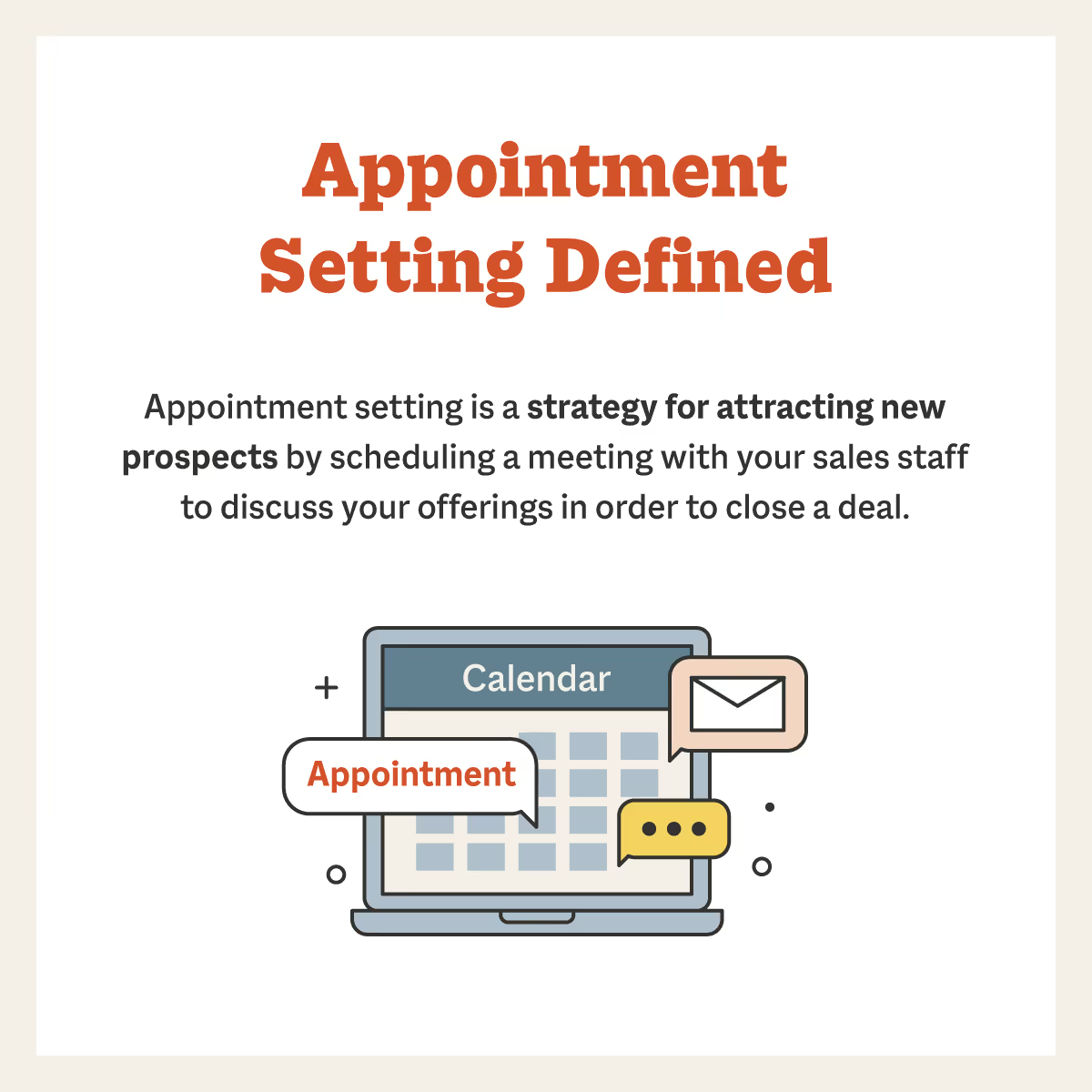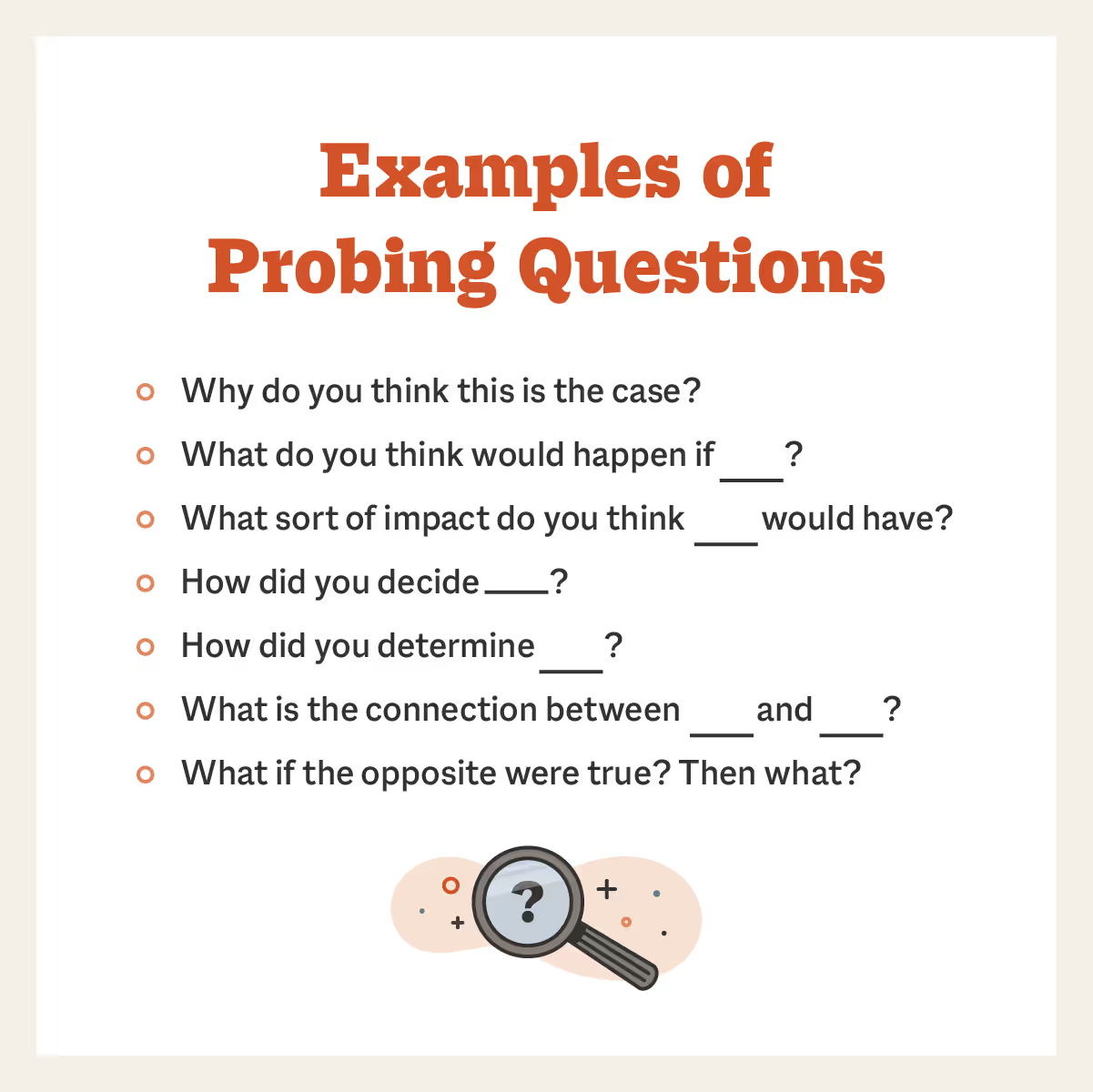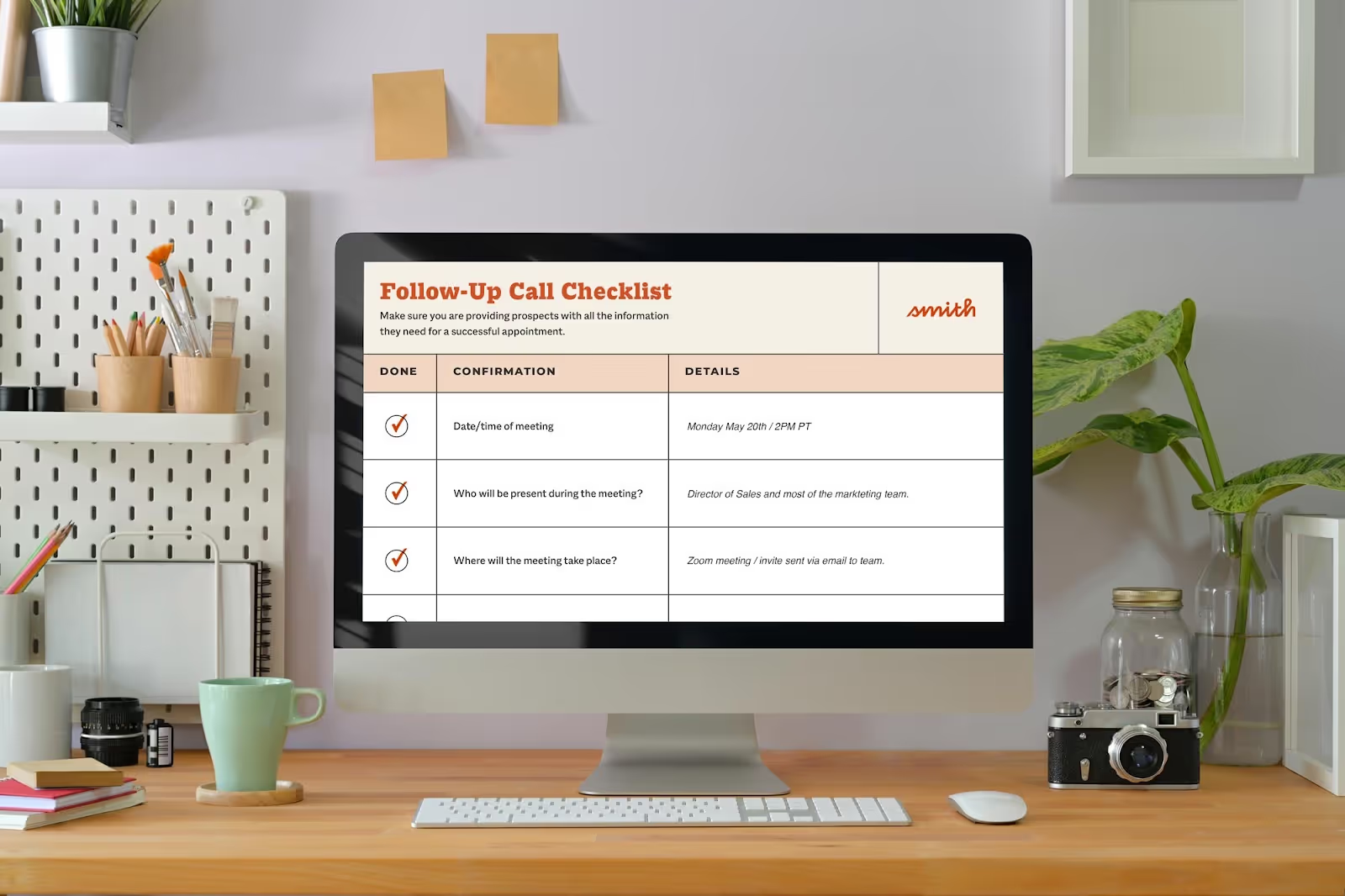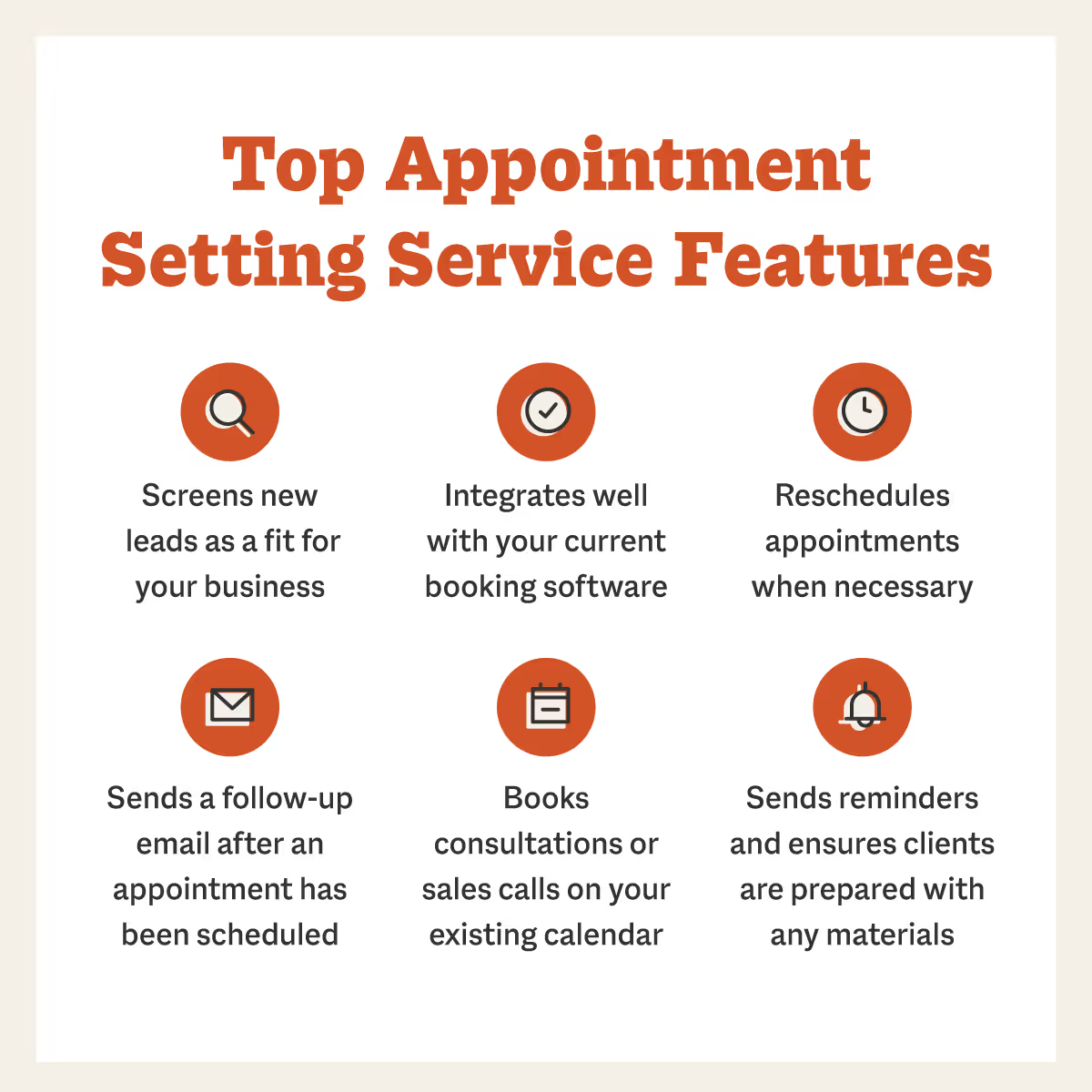Appointment Setting: Tips and Free Templates for Your Business
Appointment Setting: Tips and Free Templates for Your Business

Picture this: You're one-on-one with your ideal customer. This prospect is qualified, has expressed interest in your services, and turns out to be the perfect match! You’ve landed the deal and your sales funnel expands. Time to celebrate!
So, how did we end up in this situation? During the lead generation process there’s a strategy in place called appointment setting, in which appointment setters or sales representatives contact prospects in an attempt to schedule a meeting between them and your sales team to discuss your offerings.
Appointment setting is one of the most challenging aspects of business development, and thus a frequent obstacle to expanding your firm through more profitable sales.
Continue reading to learn more about what appointment setting is, the skills it requires, and effective appointment setting tips.

What is appointment setting?
Appointment setting is the process of conducting a series of steps to set up a sales appointment between a company and a potential buyer.
These steps include performing outreach campaigns, locating valuable information for personalization, and reaching out to these leads via phone, email, or social media.
Appointment setting has numerous advantages such as saving time, increasing profits, and gaining more visibility for your company. Setting up appointments attracts favorable attention to your business and raises awareness of your brand.
For most firms, no deal will be made without first speaking with a potential sales lead. Getting the appointment set up is more difficult than the meeting itself. In order for you to successfully close deals, you must first become a skilled appointment setter.
Appointment setting tips to advance to the next level
To be successful at appointment setting, you must create a strategy that prevents wasting valuable time and resources. Follow these 13 tips to help you create an effective appointment setting strategy.
1. Focus on the immediate goal
As a salesperson, you will always have two goals: the ultimate goal and the immediate goal.
Your ultimate goal is to close the sale and get a new client. Your immediate goal is to get the prospect to move to the next stage in your sales process.
When you have a prospect on the phone, it's tempting to focus on the ultimate goal of closing the deal. However, appointment setters must focus on the immediate goal of moving the prospect to the next stage.
Since 60% of people say no the first few contact attempts, you have a better chance of intriguing the prospect to learn more about your offerings rather than closing the deal during the initial interaction.
Key takeaway: Your strategy should be focused on interesting the prospect just enough to want to learn more during an official appointment.
2. Do the research
One of the worst things you can do while appointment setting is to perform a call without doing any research. In fact, a staggering 82% of B2B decision-makers think sales reps are unprepared.
Do your research. Have a thorough understanding of your target audience so you know their wants and needs. You also need to know the offerings you’re promoting well enough to anticipate any concerns the prospect may raise. In addition, you’ll want to make sure you have identified and will be speaking with the correct decision-maker.
You should be able to answer the following questions:
- Is there a true need for what you're offering this prospect?
- Why should the prospect be concerned about this issue at this time?
- Can you articulate the value of your solution in terms that are specific to the prospect's needs or pain points?
- Is the prospect's situation changing? (Examples: Is the company growing, have there been recent staff changes, or are industry regulations changing?)
You'll have a much higher chance of landing the appointment if you can persuade prospects to understand what's in it for them.
Use this prospect-tracking spreadsheet to keep track of all your prospects and their status to help make the research process more efficient.
Note: This spreadsheet is only compatible with Google Sheets, not Excel.


Key takeaway: Fully understand your prospects’ wants, needs, and pain points so that you are better prepared to pitch why your offering is their ideal solution.
3. Be courteous
When contacting potential leads, you can’t forget about business etiquette. Considering time zones and a prospect's busy schedule goes a long way in helping them feel respected and less annoyed, especially for cold calls.
Determine when your target decision-makers are likely to be at the office and call during those hours in their time zone. When calling a company to set an appointment, make sure you know when they are open.
If you end up getting an answer, make sure you confirm that the prospect has time to talk before diving into your pitch. This demonstrates to potential leads that you value their time –– a simple gesture that could give you a few minutes to make your case for your solution and set you on the path to scheduling an appointment.
Even if they don’t have the availability to talk at that moment (which oftentimes they don’t), ask when a good time to chat would be. Since you were courteous from the beginning, they’ll be more likely to hear you out at a later time.
Key takeaway: Research time zones before contacting leads and confirm their availability to show prospects you value their time and busy schedule.
4. Perform a quick pitch
Once you’ve confirmed your prospect’s availability, it’s time to perform a quick pitch (also known as an elevator pitch). The pitch should be one or two sentences that explain how your solution will benefit them.
Your elevator pitch could be a value statement or value proposition, some pain point instances, or a brief past client example that’s relevant to your new prospect. Make the pitch quick yet effective and always center it around the benefit of your offering, not the product/service itself.
Key takeaway: Your pitch should always be about the benefit, not the product or service itself.
5. Share solutions to their problems
At the end of the day, the client is always interested about what he or she will get out of the deal you are offering. Mention the problems that you know the prospect is experiencing based on the insights you gathered when conducting your research.
Aim to get the client to acknowledge that they have an issue by asking the right questions and stating facts you’ve learned from their business. This generates just enough interest or urgency for them to want to continue the conversation.
Since this is usually the first point of contact, you don't want to go into too much detail on the benefits and features of the product or service. The goal here is to sow the seed for future interactions –– sort of like a teaser that gives prospects a taste of what they may expect if they decide to take the next step which would be setting an appointment.
Key takeaway: Get the prospect to acknowledge they have a problem so that you can give a brief teaser as to why your offerings are their best solution.
6. Show examples of your success
Social proof is one of the most successful marketing methods for persuading potential customers that your offerings would provide them with significant benefits. In fact, 88% of buyers trust user reviews as much as personal recommendations.
Mention a few high-profile clients with whom you've had a successful working relationship. If you haven't worked with any major brands, give examples of how your solution has helped businesses in similar situations. You could even direct your prospects to a review site or landing page where they can read what satisfied consumers have to say about your product.
Case studies and client testimonials that illustrate the issues an organization encountered, how your solution helped them, and the outcomes they obtained can reassure your prospect that what you have to offer is the correct fit for them.
Key takeaway: Show prospects successful examples of how you’ve helped other businesses with similar problems to reassure them that what you have to offer is the best solution.
7. Ask good probing questions
The most effective salespeople are the ones who ask the most probing questions. Probing questions are intended to help the prospect think more deeply about the issue at hand.

Probing sales questions will help you get useful information from the prospect and make the call more interesting and dynamic. These questions will also come in handy when your sales representative meets with them for the appointment.
Key takeaway: Prepare a list of useful questions to ask the prospect during a call so you can gain valuable insights and make the conversation more interesting and engaging.
8. Prepare for any objections
What’s cold calling without a few objections, right?
In all seriousness, even if your prospect is a perfect match, chances are you’ll hear some objections. Get ahead of the game by anticipating any common objections you may come across during that first call.
Some objections you may encounter could be about your price, the timing, or their satisfaction with what they currently have. Here’s a few techniques to help you with objection handling:
.avif)
Key takeaway: Handle objections by asking clarifying questions, demonstrating your value, and highlighting data that backs up your best claims.
9. Use a script
If you are ever in doubt, use a script! While some people think scripts can make people sound robotic, there are plenty of ways to create a script that is both effective and engaging.
When developing an answering script, the most important thing to remember is to utilize it as a guide rather than a memory tool. If you use a script just to regurgitate what’s been instructed to say word for word, it sounds and feels fake to everyone.
A good script should:
- Have a branded introduction
- Tell people who you are and what company you work for
- Sound natural
Key takeaway: Use a script as a guide rather than a memorization tool to sound more engaging and help keep the conversation on track.
10. Don’t be pushy
As an appointment setter, you'll need to use some classic sales techniques to help you make the prospect set an appointment. Although this means you may need to apply a bit of pressure, don’t be too pushy. If you come on too strong too early, the prospect may become irritated and dismiss you completely.
That may sound pretty straightforward, but we don’t always sound as easy-going as we think we do. While 17% of salespeople don’t think they’re pushy, 50% of prospects disagree.
Instead of attempting to pressure the prospect into making an appointment that he or she will never keep, be consultative in your objection-busting, ask questions that demonstrate your interest, and show prospects you can provide value to their business.
Key takeaway: Set the tone for a favorable sales encounter by using persuasive language, client experiences, and facts rather than pressure techniques.
11. Ditch the sales attitude
If your prospects don't trust what you're saying or selling, they won't give you their time, much less their money. In fact, 81% of consumers stated they need to trust the brand to buy from them. To help you build their trust, you have to ditch the sales attitude and build a personal connection with them.
Building a rapport with your prospect is essential for gaining their trust since it establishes a solid foundation for future interactions. You have just a few seconds to capture a cold lead's attention, so help them relax by making the first part of your call feel natural, genuine, and engaging.
Be conversational by asking specific questions, like about the weather in their area or how they enjoyed their most recent holiday. You could even ask about their pets if you hear a dog barking in the background.
Remember, appointment setting calls are intended to encourage a prospect to agree to a more formal meeting, not to sell them something.
Key takeaway: Begin your appointment setting calls with specific and engaging conversations to help build a personal connection.
12. Confirm the appointment and follow up
Now that you've piqued the prospect's interest enough to want to continue the conversation, request to set up an appointment for further details. When you go in for the final ask, remember to be specific.
Rather than saying, “Would you like to set up a meeting to discuss next steps?” say, “How does May 14 at 11 a.m. EST work for you?”
Ideally, you should schedule the meeting during your first interaction, whether it’s on the phone, through email, or in person. Once that’s done, follow up by sending an appointment reminder with all the details.
To help, use this appointment follow-up checklist and template to make sure you’re providing your prospect with everything they need for a successful meeting.


Key takeaway: Offer a specific meeting time for the appointment and follow up with a detailed appointment reminder.
13. Outsource your appointment setting
Appointment setting is, without a doubt, a significant amount of responsibility. That is why so many businesses opt to outsource these functions. When looking for an appointment setting service, you’ll want features that make the entire process more efficient and effective.

You’ll want to find a service that integrates well with your current booking software so that all of your appointments are automatically logged in your system. Smith.ai integrates with a number of appointment scheduling software, including Acuity Scheduling, Square Appointment, and Calendly.
Key takeaway: Make sure you're using appointment scheduling software to help you be more efficient with your B2B and B2C calls.
Appointment setting is the one of the first steps toward closing a deal. In order to make the appointment setting process work, sales leaders must make sure that their approach is in sync with the rest of the sales process — from lead generation to lead nurturing.
Our team of expert virtual receptionists at Smith.ai can help you with all your appointment scheduling needs. From 24/7 phone answering to lead screening and prompt follow-ups, we’ve got you covered. Schedule a consultation now to learn how we can help accelerate growth and streamline work for your business.
Take the faster path to growth. Get Smith.ai today.
Key Areas to Explore
Technical Implementation Terms
Voice user interface (VUl) design
Speech recognition integration
Text-to-speech optimization
API connectivity and webhooks
Real-time data synchronization

Your submission has been received!














.svg)



